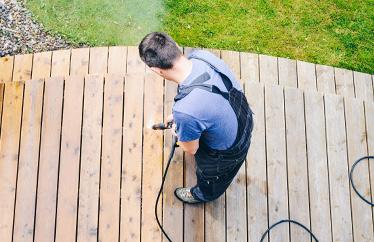Protecting your Home from High Winds & Hail

Not all high wind events become hurricanes or tornadoes, yet high winds can be a headache for homeowners and occasionally result in property damage. Most homes can withstand gusts up to 40 or 50 miles per hour, but severe weather winds have been known to exceed 100 miles per hour. This has made extreme wind and hail account for the largest share of property damage claims in the U.S between 2019 and 2023.
However, some additional foresight by homeowners can mitigate certain losses potentially incurred by heavy wind or hail. Planning ahead can help ensure you and your home stay protected. Below, you’ll find some of the most important preemptive measures you can take to avoid damage down the road.
How to Avoid Getting Blown Away by Property Damage
Survey your property and store anything that’s not bolted down. Barbecues and trampolines, for example, surprise thousands of homeowners every year by taking flight during storms, causing more damage than the replacement cost of the items themselves. Larger patio items like these should be stored prior to a storm. Tool and storage sheds should be anchored to the ground with cables or chains; smaller items like patio chairs, sports equipment and toys should be moved to a secure place indoors.
Check your yard for debris. Brittle tree branches or trees in need of pruning to prevent breakage and sick or dying trees at risk of falling or being uprooted can cause damage to your home or your neighbor’s home. You can typically dispose of yard waste through your local waste management pick-up. For larger cleanups, you may need to rent a chipper, and take it to the dump yourself or even hire a local crew for help (search for local area yard was or junk removal services).
Fact: The National Severe Storms Laboratory reports that branches begin to break and blow away when winds reach approximately 40 miles per hour, while whole trees may be uprooted at around 55 miles per hour.
Check your home’s exterior for areas with “wear and tear”. Detached weather stripping on windows and doors, loose hinges, loose rain gutters, thinner barriers like garage doors, roof tiles and shingles are small fixes that can offer big protection in case of high wind events. Easy fixes can be done when the weather is more mild and should be considered ongoing maintenance for a myriad of reasons, including the potential savings these fixes can bring to your homeowners’ insurance policy.
Have an emergency kit stocked with three days of supplies. Keep enough food, water, batteries, cash, medications to last up to three days, a flashlight and a first aid kit. In cases of winter winds, having your snow shovel or snow blower at the ready will prepare you to clear packed snow that has blown against your home, potentially blocking important ventilation areas. Keep your emergency kit in an easily accessible place all you’ll have one less thing to stress about when winds begin to blow.
Take inventory of your home and belongings. Also, make sure that your homeowners insurance policy provides enough coverage to replace anything lost to high winds or hail. Certain collections, antiques and other valuables will require official appraisals for coverage. So, make sure your insurance company has all the necessary appraisals and keep those appraisals up-to-date.
Make sure your insurance policy is up to the task of covering potentially extensive damage caused by severe winds and storms. Our recent severe weather prep survey revealed that less than a third of responding homeowners have reviewed their homeowners insurance in the past year to understand severe weather- and storm-related coverage. Certain policies guarantee either replacement cost or actual cash value for lost or damaged but there are limitations or stipulations that can leave you underinsured. Assess the likelihood of your home’s location to encounter high winds with your home insurance agent and make sure you have a policy -- or supplemental policies -- in place to account for this. Also play close attention to the varying deductibles on any supplemental policies you may put in place - they don’t all fall under the same umbrella.
When High Winds are Imminent
The National Weather Service, The Weather Channel mobile app and your local news broadcasts, including their websites and apps, are excellent resources for up-to-date alerts. Often, these sources provide specific tips and real-time information for residents in affected areas, ranging anywhere from ways to quickly secure your home to processes for reporting downed power lines and trees.
If there’s an official wind advisory in your area, turn your attention to the interior of your home, moving breakable and valuable items away from windows and smaller items to secure areas. If winds are expected to be strong enough to knock out power temporarily, consider reducing the temperature of your refrigerator and putting refrigerated items in the freezer to help preserve food a bit longer. It’s also smart to have a battery-powered radio handy so you can continue to monitor updates without the Internet.
Finally, check your homeowners insurance policy and have a copy of it easily located.
Pro Tip: Be aware of any specifications your homeowners insurance policy allows for storms and wind occurrences. Be sure to secure all belongings in accordance with your policy if you need to file a claim.
Assessing the Damage After the Storm
Should you need to file a claim, the first step is to contact your insurance company immediately.
Describe the damage to your insurer then have the insurance adjuster assess the damage as soon as possible. You will need to determine whether the damage exceeds your deductible. Based on the claims information, you can make the best determination on how to move forward with the claims process.
If the assessed cost of the damage does exceed your deductible, fill out any claim forms as soon as you receive them to expedite the repairs process. Read carefully the details of your policy in regard to required specifications your insurer may have for rebuilding or repairing. There may be details regarding which contractors, landscapers, architects, debris removal services and other professionals your policy will cover.
Similarly, additional living expenses may be covered under your policy, so make sure you know the details and limitations of these allowances.
Like all weather-related phenomena, severe winds cannot be controlled and can change unpredictably. Preparing for such unpredictability can shield you against significant losses.



